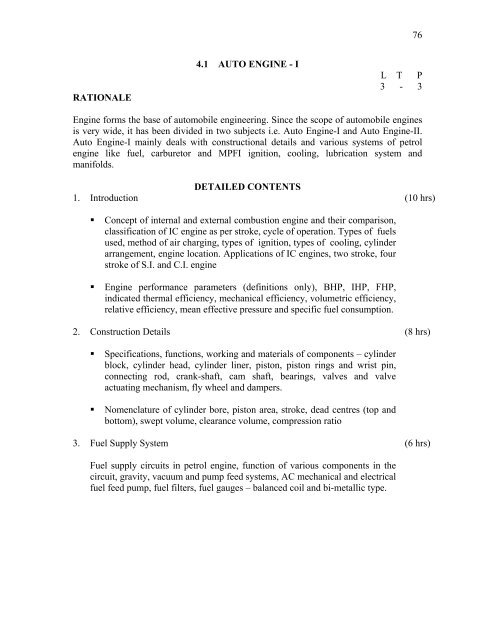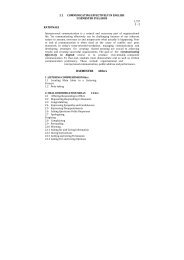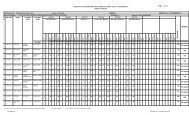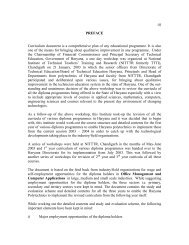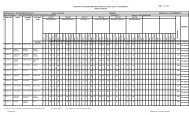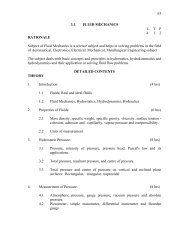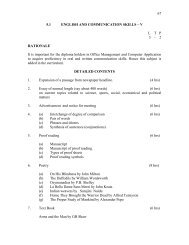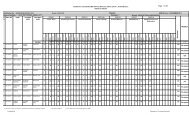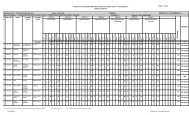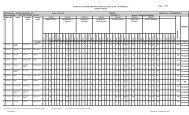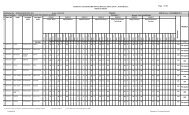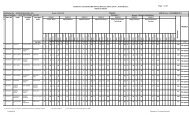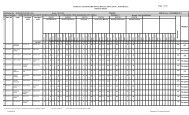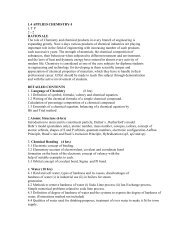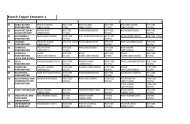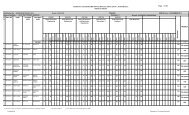76 4.1 AUTO ENGINE - I L T P 3 - 3 RATIONALE Engine ... - hsbte
76 4.1 AUTO ENGINE - I L T P 3 - 3 RATIONALE Engine ... - hsbte
76 4.1 AUTO ENGINE - I L T P 3 - 3 RATIONALE Engine ... - hsbte
You also want an ePaper? Increase the reach of your titles
YUMPU automatically turns print PDFs into web optimized ePapers that Google loves.
<strong>76</strong><br />
<strong>RATIONALE</strong><br />
<strong>4.1</strong> <strong>AUTO</strong> <strong>ENGINE</strong> - I<br />
L T P<br />
3 - 3<br />
<strong>Engine</strong> forms the base of automobile engineering. Since the scope of automobile engines<br />
is very wide, it has been divided in two subjects i.e. Auto <strong>Engine</strong>-I and Auto <strong>Engine</strong>-II.<br />
Auto <strong>Engine</strong>-I mainly deals with constructional details and various systems of petrol<br />
engine like fuel, carburetor and MPFI ignition, cooling, lubrication system and<br />
manifolds.<br />
1. Introduction<br />
DETAILED CONTENTS<br />
(10 hrs)<br />
• Concept of internal and external combustion engine and their comparison,<br />
classification of IC engine as per stroke, cycle of operation. Types of fuels<br />
used, method of air charging, types of ignition, types of cooling, cylinder<br />
arrangement, engine location. Applications of IC engines, two stroke, four<br />
stroke of S.I. and C.I. engine<br />
• <strong>Engine</strong> performance parameters (definitions only), BHP, IHP, FHP,<br />
indicated thermal efficiency, mechanical efficiency, volumetric efficiency,<br />
relative efficiency, mean effective pressure and specific fuel consumption.<br />
2. Construction Details<br />
(8 hrs)<br />
• Specifications, functions, working and materials of components – cylinder<br />
block, cylinder head, cylinder liner, piston, piston rings and wrist pin,<br />
connecting rod, crank-shaft, cam shaft, bearings, valves and valve<br />
actuating mechanism, fly wheel and dampers.<br />
• Nomenclature of cylinder bore, piston area, stroke, dead centres (top and<br />
bottom), swept volume, clearance volume, compression ratio<br />
3. Fuel Supply System<br />
(6 hrs)<br />
Fuel supply circuits in petrol engine, function of various components in the<br />
circuit, gravity, vacuum and pump feed systems, AC mechanical and electrical<br />
fuel feed pump, fuel filters, fuel gauges – balanced coil and bi-metallic type.
77<br />
4. Carburation<br />
(8 hrs)<br />
• Theory of carburation, air fuel ratio required under various conditions of<br />
operation of engine. Important circuits in carburetors – starting, idling, low<br />
speed accelerating, economy and full power circuits. Automatic chokes,<br />
description of solax and amal carburetors.<br />
• MPFI – Description and working of multipoint fuel injection. Advantages<br />
and disadvantages of M.P.F.I<br />
5. Ignition System<br />
(4 hrs)<br />
Phenomenon of carburation in petrol engine, type of spark ignition system,<br />
battery/coil and magneto ignition system. Distributor: its function, layout and<br />
drive. Automatic spark advance methods. C.B. point gap, spark plug gap<br />
adjustment. Ignition timing. Electronic ignition system.<br />
6. Cooling System<br />
(4 hrs)<br />
Necessity of cooling, types, direct and indirect, air cooling fins, blowers<br />
application, indirect or coolant cooling, pump circulation system, water jacket,<br />
water pump fan and its drive. Radiator and its types. Thermostat for<br />
temperature control, temperature gauges, pressurized cap, anti-freeze<br />
solutions, scale and corrosion.<br />
7. Lubrication Systems<br />
(4 hrs)<br />
Various lubrication systems – splash, pressure and combined splash of<br />
pressure lubrication, oil pumps, oil lines, filters, coolers, crank case<br />
ventilation. Requirements of engine lubrication oils, their specifications, oil<br />
consumption and additives for lubricants.<br />
8. Air Supply/Intake and Exhaust system<br />
(4 hrs)<br />
Inlet and exhaust manifold, consideration for good manifold design, materials.<br />
Various types of air cleaners – dry and wet, centrifugal. Exhaust silencers,<br />
different types, valve timing diagrams
78<br />
LIST OF PRACTICALS<br />
1. Servicing of lubrication system – flushing crankcase, cleaning and replacing oil,<br />
filter elements.<br />
2. Servicing of fuel system – petrol feed system, cleaning, flushing fuel tank,<br />
changing of fuel filters.<br />
3. Servicing of feed pump, mechanical, electrical pump and testing.<br />
4. Servicing of air cleaning.<br />
5. Servicing of carburetor, cleaning and adjustment.<br />
6. Setting of fuel injection pump timing of a diesel engine.<br />
7. Overhauling of fuel injector and pump.<br />
8. Servicing of valves and vale mechanism – replacement of valve, valve seats and<br />
valve seats, checking and replacement of defective springs, facing of valves,<br />
tappet and rocker arm, adjusting valve tappets.<br />
9. Dismantling and assembling water pumps. Back – flushing of cooling<br />
system/radiator.<br />
10. <strong>Engine</strong> tune up<br />
LIST OF BOOKS<br />
1. Automobile <strong>Engine</strong>ering by Dr. Kirpal Singh, Standard Publications.<br />
2. Automobile <strong>Engine</strong>ering by RB Gupta.<br />
3. Automobile <strong>Engine</strong>ering by Chitkara.
79<br />
<strong>RATIONALE</strong><br />
4.2 MATERIALS AND METALLURGY<br />
L T P<br />
3 - 2<br />
Materials play an important role in the construction and manufacturing of<br />
equipment/tools. Right selection of materials add to the economy, working and life of<br />
machinery. A diploma holder must be conversant with the properties, uses, availability<br />
and costs of materials used for construction/fabrication to enable him to perform his<br />
functions confidently. The subject of Materials and Metallurgy has been designed to<br />
cover the above aspects.<br />
DETAILED CONTENTS<br />
1. Importance of Materials<br />
(4 hrs)<br />
• Classification: Metals and non-metals, Ferrous and non-ferrous metals<br />
and their alloys<br />
• Names of common metals, their alloys and non-metals used in<br />
Industry<br />
• Properties of metals and alloys<br />
• Physical properties - Appearance, luster, colour, density and melting<br />
point<br />
• Mechanical Properties: Strength, stiffness, elasticity, plasticity,<br />
toughness, ductility, malleability, brittleness, hardness, fatigue and<br />
creep.<br />
• Thermal and electrical conductivity<br />
• Corrosion, causes, effects and prevention.<br />
2. Metallurgical Considerations<br />
(6 hrs)<br />
Solidification of metals form liquid to solid state of pure metals, cooling<br />
curves of pure metals, dendritic solidification, crystal formation, types of<br />
crystal structure. Phase diagram of:<br />
(i) Solid-state solubility.<br />
(ii)<br />
(iii)<br />
Partial solubility.<br />
Nil solubility i.e. eutectic solution (Binary only). Effects of all<br />
alloying elements on engineering materials. Effect of grain size<br />
on mechanical properties.
80<br />
3. Ferrous Metals and Alloys<br />
(12 hrs)<br />
• Flow diagram for the production of ferrous metals from their ores,<br />
constituents of iron, iron carbon diagram.<br />
• Classification, composition and uses of cast iron and plain carbon<br />
steels. IS, BS and SAE Grades<br />
• Effect of alloying elements such as Aluminium, chromium, Nickel,<br />
Cobalt, Manganese, Molybdenum, tungsten, Vanadium, Silicon,<br />
Sulphur and Phosphorous on steels.<br />
• Composition, properties, grades and uses of special steels such as High<br />
speed steel, Stainless steels, Silicon steels, Heat resistant steels, Spring<br />
steel.<br />
• Heat Treatment: Iron-carbon diagram, objectives and practical aspects<br />
of heat treatment. Brief description and uses with examples of<br />
principal heat treatment processes, Annealing, Normalizing,<br />
Tempering, Hardening, Carburising, Nitriding and Cyaniding and<br />
applications. Examples in heat-treating engineering components time,<br />
temperature transformation curve.<br />
4. Non-ferrous Metals and Alloys<br />
(12 hrs)<br />
• Copper: Properties and uses<br />
• Composition, properties and uses of copper alloys.<br />
• Brasses: Cartridge brass, Nickel silver.<br />
• Bronzes: Phosphor bronze, Al-bronze, Mn-bronze, and Gun metal.<br />
• Properties and uses of Aluminium.<br />
• Composition, properties and uses of Al-alloys e.g., Duralumin, Yellow<br />
metal, Magnalium and Hindalium<br />
• Properties and uses of alloys of lead, tin and magnesium.<br />
• Bearing Metals: Requisite qualities. Composition, properties and uses<br />
of white metal bearing, copper based bearing metals. Aluminium<br />
based bearing metals. Use of nylon/PTFE for bushes/bearings, bimetallic<br />
and tri-metallic bushes
81<br />
5. Identification and Examination of Metals and Alloys<br />
(1 hrs)<br />
Identification tests - Appearance, sound, filing, weight, magnetic, spark,<br />
bend and microstructure. Different types of etchants for preparation of<br />
surface structure.<br />
6. Other Important Materials<br />
(10 hrs)<br />
• Plastics: Definition, classification of plastics, fibre glass, reinforced<br />
plastics. Major applications of various plastics and their uses and<br />
grades.<br />
• Composite materials.<br />
• Heat insulating materials: Properties and uses of asbestos, glass wool,<br />
thermocole, cork, mica.<br />
• Electrical insulating materials. Properties and uses of china clay,<br />
leather, bakelite, ebonite, glass wool, rubber, felt.<br />
• Sound insulating materials: Cork, fibre boards.<br />
• Fabrication materials: Wood, plywood, rubber – natural and synthetic,<br />
Glass – plate glass, toughened glass, safety glass.<br />
• Refractory materials: General characteristics and uses of dolomite,<br />
ceramics.<br />
• Protective coating materials: Paints, primers, varnishes, enamels,<br />
putti, electroplating materials, rubasil, teflon coating.<br />
• Sealant and adhesives – Application and availability of sealant and<br />
adhesives for industrial user.<br />
7. Selection, specifications and commercial availability of materials<br />
(3 hrs)<br />
• Practical considerations for selection of material for different purposes<br />
• ISO/Bureau of Indian standard specifications for metals, non-metals,<br />
various components and materials.
82<br />
LIST OF PRACTICALS<br />
1. Classification of about 25 specimen of materials/parts in material lab, identify and<br />
indicate the type of materials with respect to their properties<br />
2. Study of metallurgical microscope.<br />
3. To prepare microscopic structure for examination and to examine the micro<br />
structure of specimens of various metals and alloys.<br />
4. Study of heat treatment furnaces.<br />
5. To study the effects of heat treatments processes on the following materials:<br />
(i)<br />
(ii)<br />
(iii)<br />
Low carbon steel<br />
Mild steel<br />
High Carbon Steel<br />
RECOMMENDED BOOKS<br />
1. Material Science by GBS Narang, Khanna Publishers, New Delhi.<br />
2. Material Science and Metallurgy by RB Choudary, Khanna Publishers, New<br />
Delhi.<br />
3. Material Science by RK Rajput; SK Kataria and Sons, Delhi.<br />
4. Materials and Matallurgy by D.S. Nutt. SK Kataria and Sons, Delhi.
83<br />
<strong>RATIONALE</strong><br />
4.3 CHASSIS, BODY AND TRANSMISSION - I<br />
L T P<br />
3 - 3<br />
Chassis, body and transmission forms the core of automobile engineering. The subject<br />
focuses at imparting knowledge and skills regarding chassis and body, viz. clutch system,<br />
transmission system, drive system, steering mechanism, braking system, wheels and<br />
tyres.<br />
DETAILED CONTENTS<br />
1. Chassis and Body<br />
(6 hrs)<br />
Classification of vehicles, layout of conventional type of chassis, function and<br />
arrangement of major assemblies. Alternating arrangement used such as engine<br />
position, drive types, their merits and demerits. Constructional details of car<br />
body. Materials used for chassis frames, body components, interior body<br />
dressing components, body upholstery, body streamlining, protective coatings<br />
and body air-conditioning, types of frame and body, cross members, brackets,<br />
materials for frame.<br />
2. Clutch<br />
(5 hrs)<br />
Necessity, function and requirements of clutch, types of clutch - single plate,<br />
multiplate clutch, wet and dry clutch, clutch plate and lining material<br />
3. Transmission<br />
(6 hrs)<br />
Necessity, function, types and working of transmission – sliding, constant<br />
mesh, synchromesh<br />
4. Driveline<br />
(8 hrs)<br />
Propeller shaft - function, construction details. Universal joints - functions and<br />
types. Constant velocity joints. Types of final drive – hotchkiss drive, torque<br />
tube drive. Differential – principle, functions and its working, rear axles – semi<br />
floating, fully floating, three quarter floating. Common faults and remedies
84<br />
5. Steering<br />
(8 hrs)<br />
Types of front axles and their constructional details. Steering mechanism,<br />
function Ackerman’s Principle of steering , working and constructional details<br />
of steering gear, steering linkages, front and geometry-castor, camber, steering<br />
axis inclination, toe in and toe out. Cornering force, cornering power and selfrighting<br />
torque, over steering and under steering.<br />
6. Braking System<br />
(8 hrs)<br />
Purpose of brakes, layout of hydraulic and mechanical braking system,<br />
components. Principle of hydraulic brakes, braking action, master cylinder,<br />
wheel cylinder, leading and trailing shoes, self adjusting and self releasing<br />
action, its dissipation, antilock and antiskid devices, pedal travel, brake<br />
enclosures, heat generation, its dissipation, and operating temperature, brake<br />
drum and their material, lining materials, lining thickness and lining area, brake<br />
shoes, shoe clearance, split brakes, hand brakes, brake fluids, disc brakes, brake<br />
adjusters<br />
7. Wheel and Tyres<br />
(7 hrs)<br />
Wheels – types, constructional details, specifications. Tyres - classification and<br />
purpose. Types, construction of pneumatic tyres, details of carcass of various<br />
types, comparison of cross-ply and radial-ply tyres, causes of excessive tyre<br />
wear, effects of different conditions of vehicle stability. Tyre care and<br />
maintenance, tubes and their types. Static and dynamic balance, retreading of<br />
tyres, tubeless tyres.<br />
LIST OF PRACTICALS<br />
1. Identify and service single and multiplate clutch.<br />
2. Servicing of steering system – steering gear boxes, correction and adjustment of free<br />
play.<br />
3. Servicing/overhauling of brakes – mechanical, hydraulic, brake adjustment and<br />
bleeding.<br />
4. Checking and adjustment of Camber, Caster, toe-in, toe-out, king pin inclination.<br />
5. Removing dents and minor repair, body trimming and painting.<br />
6. Wheel balancing – static and dynamic.<br />
7. Practice in brake shoe riveting, de-riveting, aligning the shoes and adjustment of<br />
brakes.<br />
8. Servicing/overhauling of gear box.
85<br />
RECOMMENDED BOOKS<br />
1. Automobile <strong>Engine</strong>ering, Vol. I by Dr. Kirpal Singh, Standard Publishers<br />
2. Automotive Chassis and Body by PL Kohli<br />
3. Automobile <strong>Engine</strong>ering by GBS Narang, Khanna Publishers, Delhi<br />
4. Automobile <strong>Engine</strong>ering by CP Nakra
86<br />
<strong>RATIONALE</strong><br />
4.4 MANUFACTURING TECHNOLOGY - II<br />
L T P<br />
3 - 4<br />
Knowledge in various machining operations viz. drilling, boring, milling, planning and<br />
grindin processes, finishing operations, gear production, CNC machining, bending<br />
forming and welding processes is very essential for the diploma holders. Hence this<br />
subject.<br />
DETAILED CONTENTS<br />
1. Drilling and Boring<br />
(8 hrs)<br />
Introduction, Types of drills, types of drilling machines i.e. portable, bench<br />
type, piller and radial, drilling speeds and feeds, drill chucks and other<br />
accessories (jigs etc.) used in drilling machines, reaming, introduction to<br />
boring, types of boring machines – horizontal and vertical, specifications,<br />
boring bar and boring heads<br />
2. Machining Processes<br />
(12 hrs)<br />
• Milling – Types of milling machines and their operations, speeds and<br />
feeds, indexing (simple and compound), types of milling cutters<br />
• Planing machines and their operation<br />
• Grinding – cylindrical, centreless and surface grinding machines, types<br />
of grinding wheels, specifications, grades and their selection, balancing<br />
of grinding wheels and their storage<br />
3. Finishing Operations<br />
(4 hrs)<br />
Lapping, honing, superfinishing operations and their applications, types of<br />
abrasives used and their selection<br />
4. Gear Production<br />
(4 hrs)<br />
Gear cutting and gear shaving machines, gear cutters and coolants<br />
5. CNC Machines<br />
(4 hrs)<br />
Introduction to CNC control systems, advantages, productivity, accuracy<br />
and cost
87<br />
6. Bending and Forming<br />
(4 hrs)<br />
Description of press brakes, bending dies, forming machines<br />
7. Welding<br />
(10 hrs)<br />
• Introduction, types of welding (gauge welding, arc welding, resistance<br />
welding), butt welding, flash, projection, seam and spot welding.<br />
Selection of electrodes, filter metals, types of welding defects and their<br />
remedies, soldering and brazing – processes and applications<br />
• Special welding processes for stainless steel and aluminium<br />
8. Types of Coolants and Lubricants for various machining processes (2 hrs)<br />
LIST OF PRACTICALS<br />
1. Introduction to drilling and boring machines, an exercise of simple drilling<br />
and boring operation, selection of speeds and feeds, use of jigs and fixtures<br />
and coolant.<br />
2. Simple exercises on shaper<br />
3. Practice on horizontal and vertical milling machines, work holding devices<br />
and types of milling cutters<br />
4. Practice on cylindrical and centreless grinding machine, selection, dressing<br />
and storage of grinding machines. Use of lubricants<br />
5. Practice on honing machines with selection of honing sticks, honing and<br />
finish pattern in the bore. Bore geometry measurement<br />
6. Observe working of CNC machines including setting of cutting parameters<br />
and dimensions and loading of tools, repeatability of operation and<br />
adjustment for wear allowances<br />
7. Visit to industry (sheet metal shoos) to observe bending and forming<br />
operation and use of dies<br />
8. Use of appropriate coolant and lubricants for all machining operation in the<br />
workshop and during Industrial visits.<br />
RECOMMENDED BOOKS<br />
1. Workshop Technology by BS Raghuwanshi, Dhanpat Rai & Sons, Delhi.<br />
2. Workshop Technology Vol. – I, II & III by Chapman, Standard Publishers<br />
Distributors, New Delhi.<br />
3. Workshop Practice by RK Singhal, SK Kataria & Sons, New Delhi.<br />
4. Production Technology by HMT, Tata McGraw Hill, New Delhi.<br />
5. Elements of Workshop Technology by SK Chaudhary & Hazra, Asia Publishing<br />
House.
88<br />
4.5 <strong>AUTO</strong> <strong>ENGINE</strong>ERING DRAWING - II<br />
<strong>RATIONALE</strong><br />
L T P<br />
- - 6<br />
An automobile engineering diploma holder, irrespective of his field of operation in an<br />
industry or transport undertaking, is expected to possess a thorough understanding of<br />
engineering drawing, which includes clear spatial visualization of the subject and the<br />
proficiency in reading and interpreting a wide variety of production drawings and<br />
maintenance drawings. Besides this, he/she is also expected to have a certain degree of<br />
drafting skills depending upon his job functions to perform his day-to-day activities e.g.<br />
communicating and discussing the ideas with his superiors and passing on instructions to<br />
his subordinates in an unambiguous way. Hence this subject. The teachers are<br />
recommended to give more emphasis to the students by showing them automobile<br />
components.<br />
Note:<br />
• All assembly drawings to be made to scale except wherever mentioned otherwise<br />
specifically<br />
• Candidates may be asked to show specific sections of the component/assembly<br />
• 50% of the drawings shall also be made by AutoCAD for which no question shall be<br />
set in the written paper<br />
• AutoCAD component shall be included in the practical/viva voce examination<br />
DETAILED CONTENTS<br />
1. <strong>Engine</strong> Components<br />
• AC fuel feed pumps (assembly)<br />
• Fuel injection pump (jerk type) (assembly)<br />
• Fuel injector (assembly<br />
• Overhead and side valve mechanism (free hand)<br />
• Water cooling system (free hand)<br />
2. Chassis Components<br />
(24 hrs)<br />
(33 hrs)<br />
• Leaf spring suspension (assembly)<br />
• Shock absorber (assembly)<br />
• Internal expanding shoe brake (assembly)<br />
• Master cylinder (assembly)<br />
• Wheel cylinder (assembly)<br />
• Independent suspension system (free hand)<br />
• Brake drum (assembly)<br />
• Air assisted hydraulic brake system (free hand)
89<br />
3. Auto Electrical Circuits (free hand sketches)<br />
(12 hrs)<br />
• Electrical circuit of battery and magneto ignition system<br />
• Automobile gauges and meters circuit diagram<br />
• Automobile lighting and signaling circuits<br />
• Complete wiring diagram of a car<br />
4. Transmission<br />
(18 hrs)<br />
• Single plate clutch (assembly)<br />
• Gear box (free hand sketch)<br />
• Rear axle (fully floating) (free hand)<br />
5. Garage<br />
(9 hrs)<br />
• Free hand sketch of a bus<br />
• Free hand layout of a garage having a fleet of 100 vehicles<br />
Note: 50% of drawings to be made using AutoCAD<br />
RECOMMENDED BOOKS<br />
1. Automobile <strong>Engine</strong>ering Drawings by RB Gupta.<br />
2. Machine drawings by PS Gill.<br />
3. Machine Drawings by Laxmi Narayan and Mathur.
90<br />
4.6 COMPUTER APPLICATIONS IN MECHANICAL <strong>ENGINE</strong>ERING<br />
L T P<br />
- - 4<br />
<strong>RATIONALE</strong><br />
Today age is computer age. Most of our daily activities are being influenced by the use<br />
of computers. While in areas like science and technology, improvements cannot be<br />
achieved without computers. It has become necessary for each and everyone of us to<br />
have a basic knowledge of application of computers. PowerPoint is a feature packed<br />
presentation programme whereas access is database management systems. Programming<br />
is backbone for preparing various technological projects, which can be achieved by C ++<br />
language – most versatile one in today’s scenario. This subject is being offered to<br />
acquaint the students about MS PowerPoint, MS Access and Programming using C ++<br />
language.<br />
DETAILED CONTENT<br />
1. Computer Application Overview (3 hrs)<br />
• Commercial and business data processing applications<br />
• <strong>Engine</strong>ering computation<br />
2. MS PowerPoint (15 hrs)<br />
2.1 Introduction<br />
• Elements of power point package- templates, wizards, views, color schemes<br />
• Starting PowerPoint<br />
• Exploring PowerPoint menus<br />
• Starting a new slide<br />
• Adding title, text and art<br />
• Moving text area and resizing text box<br />
• Starting a slide show<br />
• Saving a presentation<br />
• Printing slides<br />
• Inserting and deleting slides<br />
• Closing a presentation<br />
• Exercise for making a presentation and slide show<br />
2.2 Views<br />
• PowerPoint views – slide view, outline view, slide sorter view, notes view, slide<br />
show view, slide setup<br />
• Zoom in, zoom out<br />
• Exercises on various views of presentation
91<br />
2.3 Formatting and Enhancing text<br />
• Formatting<br />
• Changing format with a new layout<br />
• Alignment of text and text spacing<br />
• Enhancing text formatting – use of bullets, changing text font and size<br />
• Selecting text style and color<br />
• Applying design template<br />
• Closing and applying the transition<br />
• Spell checking<br />
• To set header and footer<br />
• Exercise on formatting text and applying design template.<br />
2.4 Slide with graphs<br />
• Creating a graph<br />
• Adding graphic objects<br />
• Adding clipart pictures<br />
• Adding movies and sounds<br />
• Adding multimedia to presentation<br />
• Inserting excel worksheet or word table<br />
• Exercise on inserting graphs, tables, movies and clipart.<br />
3 MS - Access (16 hrs)<br />
3.1 Introduction to Microsoft access<br />
• Components of access<br />
3.2 Table creating<br />
• Starting access, creating tables, tool bars and views of tables<br />
• Editing the design and contents of the table<br />
• Creating relationship between tables<br />
• Adding OLE objects to a table<br />
• Use of import and export facility<br />
• Exercise on table creating<br />
3.3 Query Handling<br />
• Creating a new query, use of criteria, expressions and operation<br />
• Editing a query, print a query<br />
• Exercise on creating and editing query<br />
3.4 Form designing<br />
• Introduction, creating a form, modify a form design, designing a form using<br />
design view.<br />
• Sub – forms, printing the forms, exercise on form designing.
92<br />
3.5 Report designing<br />
• Creating a report, managing the different controls of the records, saving and<br />
printing the report, use of graphs in reports<br />
• Exercise on report designing<br />
4 Programming fundamentals (6 hrs)<br />
• Algorithm, pseudo language, flow charts: advantages and disadvantages<br />
• Decision table – type, advantages and disadvantages<br />
• Structured programming: structuring the control flow, modular programming<br />
• Exercise on making algorithm and flow charts.<br />
5 C ++ programming (24 hrs)<br />
5.1 Fundamentals<br />
• Introduction, oop, character set, C ++ tokens, keywords, identifiers, constants,<br />
basic data type, declaration of variables, defining symbolic constants, assignment<br />
statement, comments in a programme, structure of C ++ programme, output using<br />
COUT, output using CIN, manipulators.<br />
5.2 Operators and Expressions<br />
• Arithmetic operators, relational operators, logical operators, shorthand assignment<br />
operator, increment and decrement operators, conditional operators, bit wise<br />
operators, precedence in C ++ operators, casting of data, standard mathematical<br />
functions.<br />
5.3 Control structures<br />
• IF statements, IF---ELSE statements, nested IF statements, switch statements, Go<br />
To statements, repetitive structures, while statements, do statement, for loop,<br />
break statement, continue statement, nested loops.<br />
5.4 Programs<br />
• Write a program to check if a number is even or odd.<br />
• Write a program to find the smallest of 3 numbers.<br />
• Write a program to find largest of 4 numbers<br />
• Write a program to find the roots of quadratic equation.<br />
• Write a program to find the sum of the first N natural numbers using a for - do<br />
loops.<br />
• Write a program that reads in N numbers and finds the smallest number among<br />
them.<br />
• Write a program to find the sum of squares of the digits of a number.<br />
6. Demonstration of CNC machine<br />
RECOMMENDED BOOKS<br />
1. MS Office 2000 for everyone by Sanjay Saxena; Vikas Publishing House Pvt. Ltd.<br />
2. MS Office 2000 by Steve Hill; BPB Publications.<br />
3. Programming in C++ by B. Subharamanayam.<br />
4. Programming in C by Abdul Khader; Ajanata Publications
93<br />
INDUSTRIAL TRAINING<br />
Industrial Training aims at exposing the students to field practices, size and scale of<br />
operations and work culture at practical sites. For this purpose, students at the end of<br />
fourth semester, are required to be sent for a period of 4 weeks at different work sites.<br />
Each student is supposed to study the material and technology used at site and prepares a<br />
detailed project report of the observation of processes seen by him/her. These students<br />
should be supervised and guided by respective subject teachers. Each teacher may guide a<br />
group of four to five students.<br />
The teacher along with field supervisors will conduct performance assessment of<br />
students. The components of evaluation will include the following.<br />
- Punctuality and regularity 15%<br />
- Initiative in learning new things 15%<br />
- Relationship with workers 15%<br />
- Industrial training report 55%


